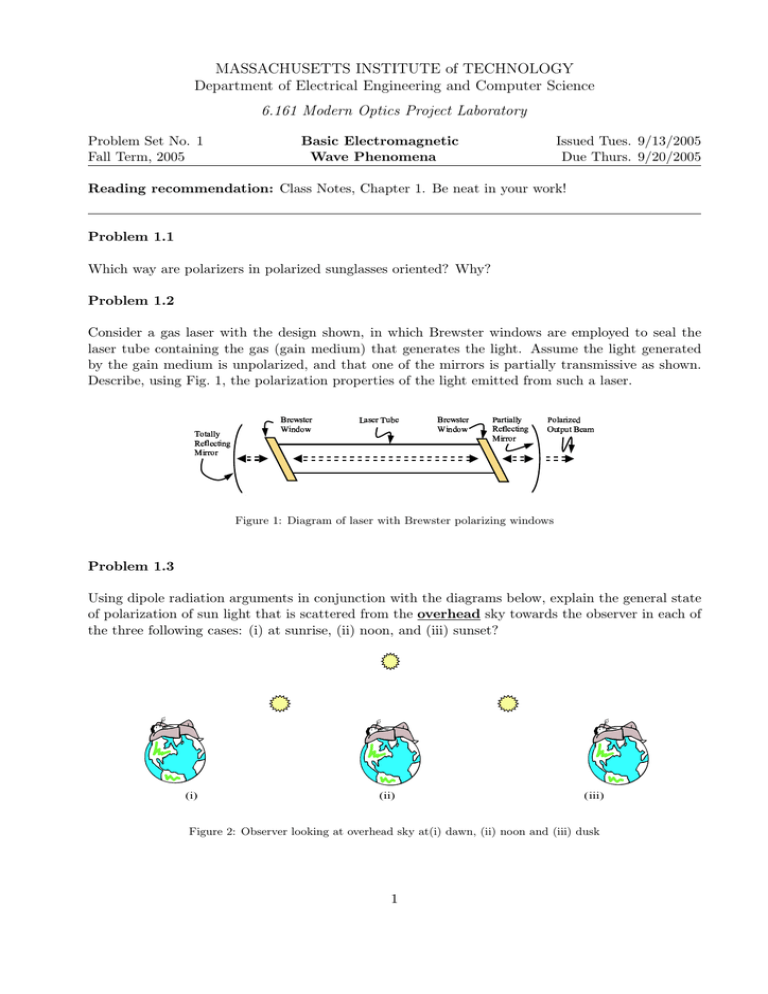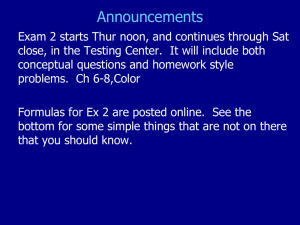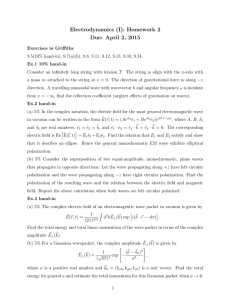MASSACHUSETTS INSTITUTE of TECHNOLOGY Department of Electrical Engineering and Computer Science 6.161
advertisement

MASSACHUSETTS INSTITUTE of TECHNOLOGY Department of Electrical Engineering and Computer Science 6.161 Modern Optics Project Laboratory Problem Set No. 1 Fall Term, 2005 Basic Electromagnetic Wave Phenomena Issued Tues. 9/13/2005 Due Thurs. 9/20/2005 Reading recommendation: Class Notes, Chapter 1. Be neat in your work! Problem 1.1 Which way are polarizers in polarized sunglasses oriented? Why? Problem 1.2 Consider a gas laser with the design shown, in which Brewster windows are employed to seal the laser tube containing the gas (gain medium) that generates the light. Assume the light generated by the gain medium is unpolarized, and that one of the mirrors is partially transmissive as shown. Describe, using Fig. 1, the polarization properties of the light emitted from such a laser. Figure 1: Diagram of laser with Brewster polarizing windows Problem 1.3 Using dipole radiation arguments in conjunction with the diagrams below, explain the general state of polarization of sun light that is scattered from the overhead sky towards the observer in each of the three following cases: (i) at sunrise, (ii) noon, and (iii) sunset? (i) (ii) (iii) Figure 2: Observer looking at overhead sky at(i) dawn, (ii) noon and (iii) dusk 1 That is, your answer will explain the mechanism which accounts for the partial polarization of sky light. Draw as many diagrams as you need for a clear explanation. (Note: we are NOT asking about the color of the sky.) Problem 1.4 (a) What is the general polarization state of light scattered from clouds? Explain and use diagrams to help clarify your answer.. (Note: we are NOT asking why the sky is blue.) (b) Why is the sky blue? Explain and use diagrams to help clarify your answer. (c) How are rainbows formed? Explain and use diagrams to help clarify your answer. Problem 1.5 Consider a plane electromagnetic wave that is described by � E(r, t) = �e (ˆ x + jŷ)E0 e j( 2π 2π z− t) 1×10−6 1×10−13 � where all units are in MKS. For the following questions, be thorough with your derivations! No credit be given for answers without explanation or calculation. (a) What is the amplitude of the wave? (b) What is the polarization state of the wave? (c) What is the direction of propagation? (d) What is the wave-number, k? (e) What is the temporal frequency, ν, of the wave? (f) What is the wavelength, λ, of the wave in free-space? (g) What is the index of refraction, n, in the media? (h) *Write the equation for the H-field associated with this wave. (i) What is the complex Poynting vector for the wave? (j) What is the time-averaged power density associated with the wave? Problem 1.6 A light beam of wavelength 633nm traveling in a glass block of reflective index 1.53 is incident at an angle of 60˚ with the glass-air interface. (a) Compute the penetration depth of the evanescent field into the air. (b) If a thick (much greater than the penetration depth) layer of absorbing dielectric material of refractive index 1.35 is coated on the surface of the glass, what would you expect to happen to the internally reflected beam? Why? 2






